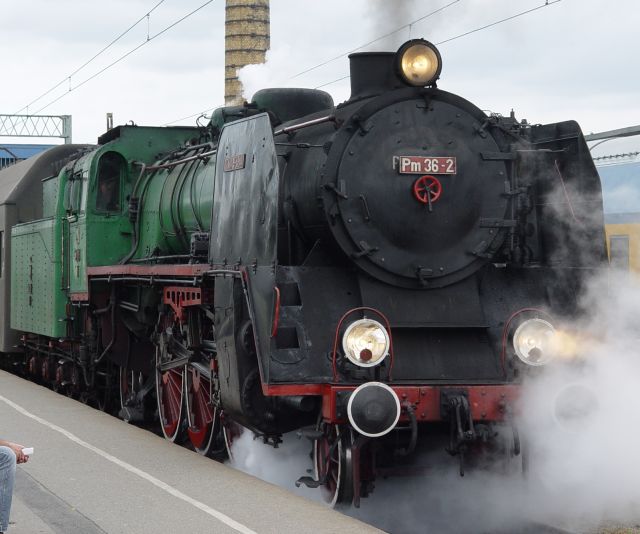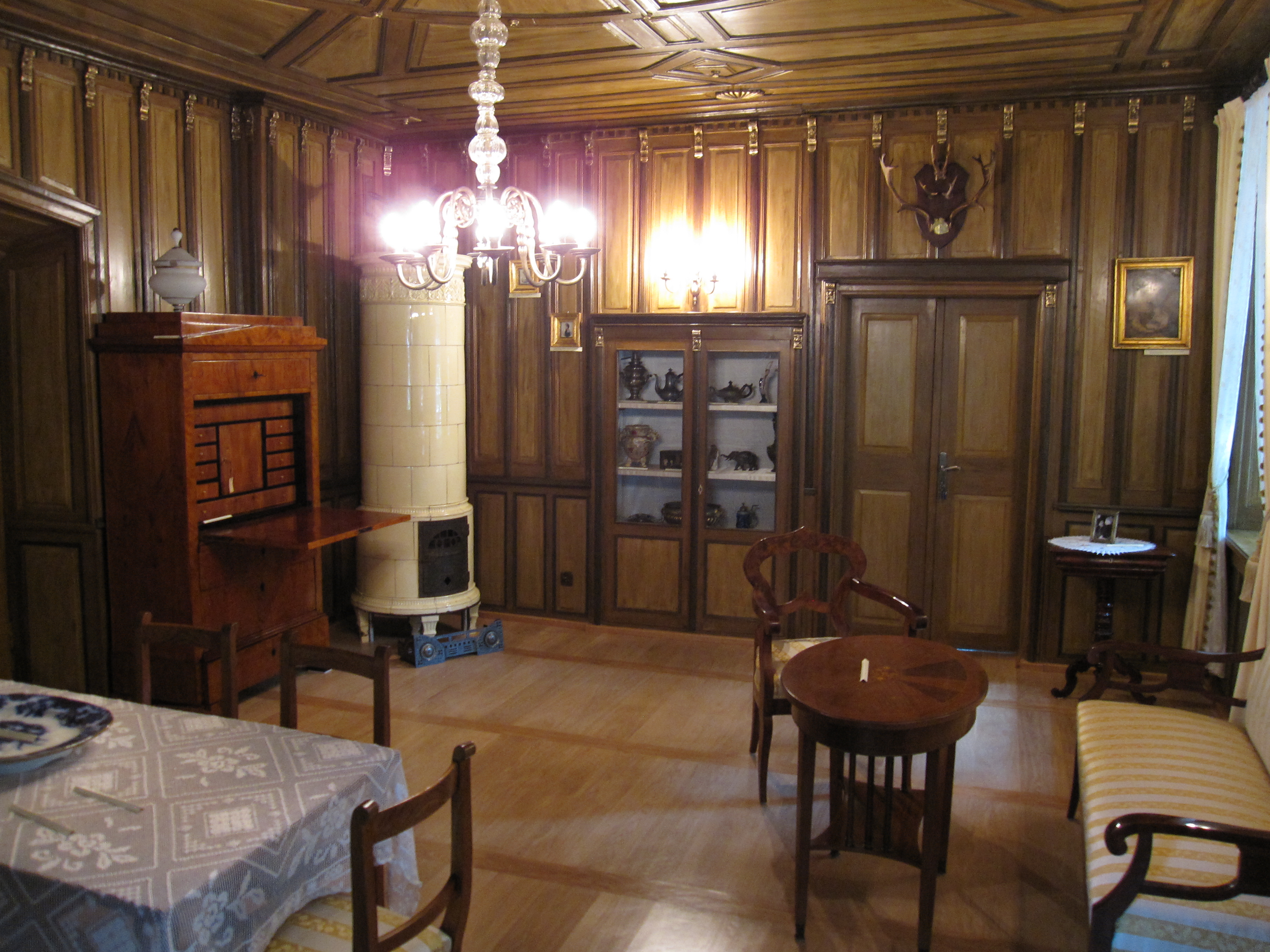|
Irena And Mieczysław Mazaraki Museum
The Irena and Mieczysław Mazaraki Museum () is a regional museum in Chrzanów in Lesser Poland Voivodeship. It was once the home of Henry Lowenfeld, a 19th-century entrepreneur and migrant into Great Britain. History It was founded in 1960 as an independent cultural institution of the municipality of Chrzanów. It focuses on the culture and industry in the western part of Lesser Poland. The permanent exhibition is housed at ulica Mickiewicza 13 in the former mansion of Henry Lowenfeld who settled in England. It presents the history, culture and nature studies of the Chrzanów's region, including flora and fauna and a geology collection. There is a section devoted to local Jewish history with a miniature model of the historical Chrzanów Synagogue. Industry is represented by a permanent exhibit about Fablok, the first locomotive factory in Poland. Some of the original interior of the Loewenfeld mansion is also preserved in the Biedermeier salon. The sponsors of the museum wer ... [...More Info...] [...Related Items...] OR: [Wikipedia] [Google] [Baidu] |
Chrzanów
Chrzanów () is a town in southern Poland with 35,651 inhabitants as of December 2021. It is situated in the Lesser Poland Voivodeship (since 1999) and is the seat of Chrzanów County. History History to 1809 It is impossible to establish a reliable date for the foundation of the town. A stronghold existed on the site, which was later raised to the rank of a castellany. The earliest documents which corroborate the existence of Chrzanów castellany come from the late 12th century when, in around 1178, Chrzanów castellany was annexed to Silesia by order of Duke Casimir II the Just. In the second half of the 13th century it was reunited with the Duchy of Kraków. In 1241 the wooden stronghold of Chrzanów was put to the torch by Mongol hordes invading Poland from the east. The town of Chrzanów was rebuilt according to the Magdeburg Law in the mid-14th century under the reign of King Casimir III the Great. However it seems that it was not surrounded by defence walls. It is be ... [...More Info...] [...Related Items...] OR: [Wikipedia] [Google] [Baidu] |
Lesser Poland Voivodeship
Lesser Poland Voivodeship ( ) is a voivodeships of Poland, voivodeship in southern Poland. It has an area of , and a population of 3,404,863 (2019). Its capital and largest city is Kraków. The province's name recalls the traditional name of a historic Polish region, Lesser Poland, or in Polish: . The current Lesser Poland Voivodeship, however, covers only a small part of the broader ancient Małopolska region, which stretched far north, to Radom and Siedlce, also including such cities as Lublin, Kielce, Częstochowa, and Sosnowiec. The province is bounded on the north by the Świętokrzyskie Mountains (), on the west by ''Jura Krakowsko-Częstochowska'' (a broad range of hills stretching from Kraków to Częstochowa), and on the south by the Tatra mountains, Tatra, Pieniny Mountains, Pieniny and Beskidy Mountains. Politically, it is bordered by Silesian Voivodeship to the west, Świętokrzyskie Voivodeship to the north, Subcarpathian Voivodeship to the east, and Slovakia (Prešo ... [...More Info...] [...Related Items...] OR: [Wikipedia] [Google] [Baidu] |
Henry Lowenfeld
Henry Lowenfeld in Polish, ''Henryk Loewenfeld'', (1 September 1859 – 4 November 1931) was a Polish-born British entrepreneur and theatrical impresario. He founded the Kops Brewery, the UK's first UK brewer of non-alcoholic beer, and built London's Apollo Theatre and the Ocean Hotel in Sandown on the Isle of Wight. Early life He was born in Warsaw, the son of a tycoon, Emanuel Loewenfeld and his wife, Rose, who were said to own the town of Chrzanów in Lesser Poland. He emigrated to England in the early 1880s, "with about $10 in his pocket". His childhood home at ul. Mickiewicza 13, Chrzanów, Poland is now the Irena and Mieczysław Mazaraki Museum. Career In 1890, Lowenfeld built the Kops Brewery, the UK's first producer of non-alcoholic beer in Townmead Road, Fulham, London. The name of the brewery is thought to have been based on the word "hops". In December 2014, the renovated building received a blue plaque from the Hammersmith & Fulham Historic Buildings Group, stating ... [...More Info...] [...Related Items...] OR: [Wikipedia] [Google] [Baidu] |
Gmina Chrzanów, Lesser Poland Voivodeship
Gmina Chrzanów is an urban-rural gmina (administrative district) in Chrzanów County, Lesser Poland Voivodeship, in southern Poland. Its seat is the town of Chrzanów, which lies approximately west of the regional capital Kraków. Overview The gmina covers an area of , and as of 2006 its total population is 49,752 (out of which the population of Chrzanów amounts to 39,797, and the population of the rural part of the gmina is 9,955). The gmina contains part of the protected area called Tenczynek Landscape Park. Villages Apart from the town of Chrzanów, Gmina Chrzanów contains the villages and settlements of Balin, Luszowice, Płaza and Pogorzyce. Neighbouring gminas Gmina Chrzanów is bordered by the city of Jaworzno and by the gminas of Alwernia, Babice, Libiąż Libiąż is a town in Chrzanów County, Lesser Poland Voivodeship, Poland, with 17,671 inhabitants (2004). Location Libiąż is located in the eastern part of the Upper Silesian Industrial Region, Up ... [...More Info...] [...Related Items...] OR: [Wikipedia] [Google] [Baidu] |
Lesser Poland
Lesser Poland, often known by its Polish name ''Małopolska'' (; ), is a historical region situated in southern and south-eastern Poland. Its capital and largest city is Kraków. Throughout centuries, Lesser Poland developed a separate culture featuring diverse architecture, folk costumes, dances, cuisine, traditions and a rare Lesser Polish dialect. The region is rich in historical landmarks, monuments, castles, natural scenery and UNESCO World Heritage Sites. The region should not be confused with the modern Lesser Poland Voivodeship, which covers only the southwestern part of Lesser Poland. Historical Lesser Poland was much larger than the current voivodeship that bears its name. It reached from Bielsko-Biała in the southwest as far as to Siedlce in the northeast. It consisted of the three voivodeships of Kraków, Sandomierz and Lublin. It comprised almost 60,000 km2 in area; today's population in this area is about 9,000,000 inhabitants. Its landscape is mai ... [...More Info...] [...Related Items...] OR: [Wikipedia] [Google] [Baidu] |
Fablok
Fablok is a Polish manufacturer of locomotives, based in Chrzanów. Until 1947 the official name was ''First Factory of Locomotives in Poland Ltd.'' (), Fablok being a widely used syllabic abbreviation of ''Fabryka Lokomotyw'', among others as the company's telegraphic address. It is now named "BUMAR - FABLOK S.A.". Fablok is located in the town of Chrzanów in Lesser Poland. As of 2009, Fablok no longer builds new locomotives. History Early years 1919-1939 Fablok was established in 1919. A year later a contract was signed with the Polish government to supply 1,200 steam locomotives within ten years to the Polish State Railways (PKP). The first locomotive was delivered on 7 April 1924. In 1931, the first locomotive was exported to the Bulgarian State Railways. During 1935 and 1936, five electric locomotives were built under license from Metropolitan-Vickers. In 1935–1936, Fablok produced five Luxtorpedas (fast railcars) for PKP under the guidance of engineer Klemens St ... [...More Info...] [...Related Items...] OR: [Wikipedia] [Google] [Baidu] |
Biedermeier
The Biedermeier period was an era in Central European art and culture between 1815 and 1848 during which the middle classes grew in number and artists began producing works appealing to their sensibilities. The period began with the end of the Napoleonic Wars in 1815 and ended with the onset of the Revolutions of 1848. The term originated in popular literature, before spreading to architecture, interior design, and visual arts. "Biedermeier" derives from the fictional mediocre poet Gottlieb Biedermaier, who featured in the Munich magazine ''Fliegende Blätter'' (''Flying Leaves''). It is used mostly to denote the unchallenging artistic styles that flourished in the fields of literature, music, the visual arts and interior design. As is natural in cultural creative movements, ''Biedermeier'' has influenced later styles. Political background The ''Biedermeier'' period does not refer to the era as a whole, but to a particular mood and set of trends that grew out of the unique ... [...More Info...] [...Related Items...] OR: [Wikipedia] [Google] [Baidu] |
John Paul II
Pope John Paul II (born Karol Józef Wojtyła; 18 May 19202 April 2005) was head of the Catholic Church and sovereign of the Vatican City State from 16 October 1978 until Death and funeral of Pope John Paul II, his death in 2005. In his youth, Wojtyła dabbled in stage acting. He graduated with excellent grades from an All-boys school, all-boys high school in Wadowice, Poland, in 1938, soon after which World War II broke out. During the war, to avoid being kidnapped and sent to a Forced labour under German rule during World War II, German forced labour camp, he signed up for work in harsh conditions in a quarry. Wojtyła eventually took up acting and developed a love for the profession and participated at a local theatre. The linguistically skilled Wojtyła wanted to study Polish language, Polish at university. Encouraged by a conversation with Adam Stefan Sapieha, he decided to study theology and become a priest. Eventually, Wojtyła rose to the position of Archbishop of Kra ... [...More Info...] [...Related Items...] OR: [Wikipedia] [Google] [Baidu] |
Jewish Cemetery Of Chrzanów
Jews (, , ), or the Jewish people, are an ethnoreligious group and nation, originating from the Israelites of History of ancient Israel and Judah, ancient Israel and Judah. They also traditionally adhere to Judaism. Jewish ethnicity, religion, and community are highly interrelated, as Judaism is their ethnic religion, though it is not practiced by all ethnic Jews. Despite this, religious Jews regard Gerim, converts to Judaism as members of the Jewish nation, pursuant to the Conversion to Judaism, long-standing conversion process. The Israelites emerged from the pre-existing Canaanite peoples to establish Kingdom of Israel (Samaria), Israel and Kingdom of Judah, Judah in the Southern Levant during the Iron Age.John Day (Old Testament scholar), John Day (2005), ''In Search of Pre-Exilic Israel'', Bloomsbury Publishing, pp. 47.5 [48] 'In this sense, the emergence of ancient Israel is viewed not as the cause of the demise of Canaanite culture but as its upshot'. Originally, J ... [...More Info...] [...Related Items...] OR: [Wikipedia] [Google] [Baidu] |






